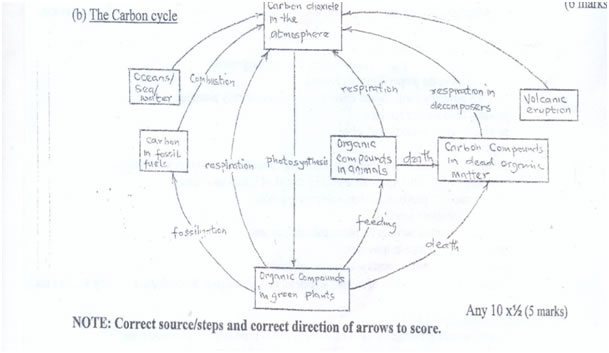Question 6
(a) Copy and complete the table below.Diseases |
One effect |
One remedy |
Kidney stones |
|
|
Nephritis |
|
|
Diuresis |
|
|
[6 marks]
(b) Make a labelled diagram of the carbon cycle. [5 marks]
(c)
(i) What is an Estuarine habitat? [2 marks]
(ii) Construct a food chain typical of an Estuarine habitat. [2 marks]
(d)
(i) Name two pests and two diseases that can attack plant crops. [4 marks]
(ii) State three ways of controlling plant diseases. [3 marks]
(e) State four functions of a public health authority. [4 marks]
(f) State four ways of maintaining food hygiene in the community. [4 marks]
Observation
Question 6(a) was fairly answered.
Majority of the candidates drew the Carbon cycle without showing the direction of flow with arrow heads. Some candidates could not link the activities with CO2 production. Majority of the candidates answered questions 6 (c) (i) and (ii) quite well but could not show the direction of the arrows in (c) (ii), the food chain properly.
Questions 6 (d) (i) was well attempted but for bad spelling of the technical terms.
Candidates performed poorly when stating the answers to questions (e) and (f).
The expected answers are:
6. (a) Kidney diseases
Diseases |
One effect |
One remedy |
Kidney stones |
Abdominal pains; decreased frequency of urination; pains during urination; presence of blood in the urine; increased blood pressure. |
Drink plenty of water |
Nephritis |
Oedema/swelling of feet and ankle; high blood pressure; blood in urine/blood cells in urine/dizziness/back pain/fatigue;/general weakness; inflammation of the kidney tubules. |
Consult a physician; kidney transplant; dialysis/all food items must be washed/cooked properly; drinking water boiled/filtered/sterilized |
Diuresis |
Thirst/dehydration occurs; high blood pressure may occur; loss of appetite; weakness; fatigue; nausea; loss of serum electrolyte. |
Consult a physician; avoid fans/air conditions in cold weather; avoid excessive drinking of alcohol. |
(b)

(c) (i) Estuarine habitat
Is the place/point where a river enters the ocean/sea; into which the tides flow; fresh water mixes with water; to form brackish water.
(ii) Food chain typical of an estuarine
Phytoplanktons barnacles fish bird OR
Detritus worm mollusc bird OR
Detritus shrimp fish bird
All must be correct to score
Correct sequence (CS) x 1 mark
Correct direction with arrow (CD) x 1 mark
(d) (i) Pests that can attack plant crops
Stem borer; army worms; weevils; black tea-thrips; aphids; root mealybugs; variegated grasshopper; beetle; rodents; squirrel; locust; birds; mites; cotton stainer; any correctly named examples.
NOTE: Spelling must be correct to score.
Diseases that can attack crops
Leaf spots; cankers; rosette; rice blast, root knots; swollen shoot of cocoa; sigatoka; black pod of cocoa; freckle; root/stem rots; bacteria blight; smut; downy mildew; powdery mildew/ any correctly named disease.
NOTE: Spelling must be correct to score.
(ii) Ways of controlling plant diseases
(e) Functions of a public health authority
(f) Ways of maintaining food hygiene
